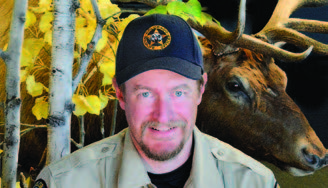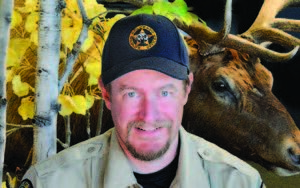
Aaron Berscheid is a district wildlife officer for Colorado Parks and Wildlife. Aaron covers the “wild” side of Northeast El Paso County, including Black Forest, Falcon, Peyton and Calhan. He also covers some of Elbert County, north of U.S. Highway 24 and south of State Highway 86, including the towns of Elbert, Kiowa, Ramah, Simla, Matheson and a small portion of the Limon area.
Don’t orphan young wildlife by intervening in nature
By Aaron Berscheid
District Wildlife Manager, CPW
We are in the midst of the rush of new life in the world of wildlife.
Hatchling owls are transitioning to fledglings. Songbirds are hatching. Camouflaged fawns on wobbly legs are trying to keep up with their does. Coyotes are having pups. Bear cubs born in their winter dens are tagging along behind their sows.
Typically, this rite of spring — new life coming to our forest and meadows — goes smoothly and does not draw too much attention.
However, every once in a while, humans observe something they think is off. Maybe it’s a fawn lying perfectly still in their yards with its doe nowhere to be seen. Or it’s a young owl on the ground, seemingly abandoned. Maybe it’s an aggressive coyote acting up on a favorite hiking trail.
Sometimes these situations deserve a second look by a wildlife expert.
But sometimes, the situation is completely misunderstood.
To avoid doing something that will leave a baby animal orphaned, or worse, please follow this advice: Leave young wild animals alone and do not approach them.
For the vast majority of these encounters, this rule applies.
There are countless reasons for baby animals to be left by their mothers on their own. Don’t apply human logic to nature. Wild animals have been surviving for eons without human interference. So, in general, you are best to leave these animals alone.
That same rule applies to animals that appear injured. Some animals actually intentionally look injured to draw attention away from their babies that might be nearby.
So let’s talk about what we should do when we have an encounter with an odd wild animal situation.
Keeping your distance protects both the animal and the human. Your safety is most important and there could be hazards associated with wild animals.
My advice is to take a video and call our office at 719-227-5200 during normal business hours. Our staff is trained to assess these situations over the phone, in most cases. Most have biology degrees and a lot of experience with wildlife, so please trust their judgment.
If it is after hours or on the weekends, you can call the Colorado State Patrol non-emergency line at 719-544-2424. A wildlife officer will be contacted and can assess the situation.
If it is a deer fawn, it is very important that you do not intervene!
Fawns are left by their mother while they go to get food to be able to produce milk to feed their babies. Also, because the babies do not have a smell, moms do not hang around their fawns to make sure they don’t draw the attention of predators. At times, mother deer will leave their fawns up to 12 hours at a time.
The worst option for the fawn is to remove it from the location that the mom left it. If its mother returns to find the fawn missing, that fawn’s chances of survival have dropped to near zero. You have orphaned that fawn and its future is bleak.
Another reason to keep your distance is to protect yourselves. Mother deer will aggressively protect their fawns. Approach with a dog and the doe will attack. This means it is important to keep your dogs on a leash this time of year and under your physical control so that your dogs do not get into an encounter with a momma deer.
If you think a fawn has not been attended to in more than two days, please contact us. We will see if the fawn is truly abandoned or not. The decision to rehabilitate the fawn does not come lightly because as soon as that fawn is removed from where it is at, its chances of survival are not good.
The only time we will remove a fawn to take it to rehab is if it is truly abandoned or if someone has taken the fawn from where it was hiding to “rescue” it. There are very few rehab facilities and they often reach capacity.
Another animal people often encounter this time of year are fledgling birds. These can be owls or hawks or just common song birds. Just as baby humans aren’t good at walking at first, birds take a bit of time and practice to fly.
Often, you will find birds on the ground that look “fluffy.” If you look around you will probably see adult birds of the same species keeping an eye on the fluffy ones on the ground. Most of the time, fledgling birds will be testing their wings and it will only be a matter of time before they are flying on their own.
If you keep a safe distance, you might be lucky enough to watch the young bird’s parents feeding it while it is on the ground.
These are the most common encounters this time of year, but there are a myriad of other wild things you might come across. Best advice is to not approach. Instead, take a video and call CPW.
In the coming months, I’ll share more stories as I write about wildlife issues in our community. Got a question, problem or column idea? Please email me at aaron.berscheid@state.co.us or call me at 719-227-5231.
I might even answer your question in a future installment of “Wildlife Matters.”




